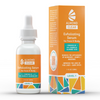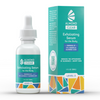June 20, 2018
Fungal Acne Symptoms
"Fungal acne" (aka pityrosporum folliculitis or malassezia folliculitis - pictured above) is a type of breakout caused by fungal growth in the hair follicles. It's been coined “acne” because of its pimple-like appearance, but the name is misleading. True acne occurs in the pores, not the hair follicles, and is caused by a mix of dead skin cells, sebum, and bacteria, not fungus. Though these conditions have different causes, they look quite similar, making it important to know the symptoms of fungal acne so that you can choose effective treatments.
5 Symptoms of Fungal Acne
- Fungal acne (aka folliculitis) often itches or burns, while regular acne nearly never causes these sensations. If your breakouts itch, then it’s very likely that they’re caused by fungus.
- Fungal acne is often topped by whitehead-like pustules, but it doesn’t produce blackheads. Fungal acne blemishes are often smaller and appear mostly similar in size and shape, with an occasional blemish getting more inflamed. In contrast, true acne breakouts often contain many different sizes and types of blemishes, from tiny whiteheads and blackheads to medium and large cysts.
- Fungal acne gets worse in warm, humid conditions. If you notice that your breakouts mostly occur during the summer months or when you’ve been exercising regularly (working out heats up the body and traps sweat against the skin, causing fungus to spread), then you likely have a fungal problem. Fungal acne tends to come and go for longer periods of time, whereas true acne is more consistent.
- Fungal acne often occurs in areas where sweat or moisture are trapped against the skin for prolonged periods of time, like the chest, back, thighs, and butt. It's also common for fungal acne to occur on the forehead and other areas of the face that produce sweat.
- Fungal acne doesn’t respond to typical acne treatment products that are found in drugstores. If you’ve tried lots of different acne products for your breakouts and haven’t noticed any measurable difference, and you have most of the symptoms listed above, then there’s a good possibility that you have fungal acne.
6 Treatment Suggestions for Fungal Acne
- Mandelic acid: Mandelic acid is an alpha hydroxy acid that’s derived from bitter almonds. It has strong antifungal and antibacterial properties, and it also clears clogged follicles and pores of congested material. Mandelic acid products have excellent track records for tackling difficult cases of fungal acne.
- Wash with a product that contains ketoconazole. Ketoconazole is an antifungal ingredient that’s highly effective in treating dandruff. Many people have also found that it helps to battle fungal acne, and there is some research to support this claim. You can find ketoconazole in Nizoral, a dandruff shampoo that used to require a prescription but is now available over-the-counter. Nizoral is sold in places like Target and Walgreens. For best results, apply the shampoo to dry skin before showering, then wait a few minutes to let it soak in before rinsing in the shower
- Avoid the skincare products that make fungal acne worse. The malassezia yeast that causes fungal acne is fed by oil. Any products that contain oil or fatty acids are going to make your problem much worse. If you want to check out an excellent, truly comprehensive blog post on the types of skin care products to use avoid, then read this post by Simple Skincare Science.
- Change your post-workout routine: Fungus thrives in moist, warm conditions, which is what occurs on your skin after a good workout. There are a few easy changes that can make sweaty skin a less hospitable place for fungus. First off, make sure to wear breathable clothing. Synthetic fibers like nylon, polyester, and lycra tend to trap moisture against the skin. Cotton and other natural fibers are much more breathable and will help your skin to dry out more quickly. It’s also very important to shower as soon as possible after exercising. Instead of running errands in sweaty gym clothes, hop in the shower first! If you can’t find time to shower, then bring a change of clothes so that your skin isn’t lingering in sweat, and wash your face thoroughly.
- Take an antifungal supplement: Taking an antifungal supplement is a good complement to your topical skin care routine (see #1 and #2 above). Many people report that antifungals help them to keep their fungal acne under control, but it’s important to change your antifungal about every month so that your body doesn’t get too accustomed to the formula. Good antifungals include garlic extract, oil of oregano, Berberine, Caprylic acid, grape seed extract, and echinacea extract. You should consult with your doctor before taking any new supplement.
- Seek the guidance of a medical professional: A dermatologist can evaluate your skin, test your blemishes to see if they contain fungus or bacteria, and prescribe an oral antifungal medication or topical prescription. You may also want to talk with your doctor about changes to your diet that could help with fungal infections. Excessive consumption of sugar, simple carbohydrates and alcohol can feed fungal infections. A doctor could help you make sensible changes to your diet that could improve your fungal acne.








